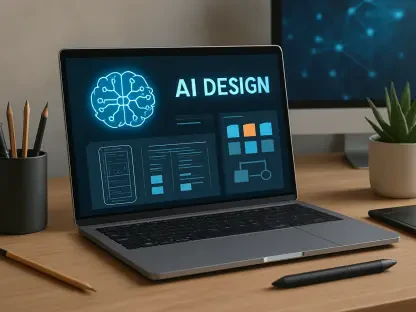In the ever-evolving landscape of software development, Agile methodologies such as Scrum and Kanban have cemented their place as essential frameworks for teams striving to remain adaptable and deliver results through iterative cycles. At the core of Agile lies a fundamental principle: valuing individuals and interactions over strict processes and tools. This human-centric focus makes teamwork—embodied in communication, collaboration, and coordination—absolutely critical to success. Now, imagine the impact when a transformative force like Artificial Intelligence (AI) enters this space. Already a powerhouse in industries through automation and predictive capabilities, AI is beginning to reshape the dynamics of Agile teams. This exploration delves into the profound ways AI is enhancing team interactions, offering a window into a future where technology and human effort merge seamlessly to elevate software development.
Picture a scenario where repetitive, time-consuming tasks in software projects are seamlessly managed by intelligent systems, allowing developers to channel their energy into creative problem-solving and innovation. AI is making this a reality by stepping into roles such as bug detection, task prioritization, and even analyzing team morale. Yet, its integration into Agile teamwork—a domain defined by rapid adaptability and quick decision-making—remains a relatively uncharted territory. Emerging research highlights a growing momentum in this area, sparking intrigue about how AI can support the foundational elements of team synergy. The journey into this intersection of cutting-edge tech and Agile practices promises to reveal groundbreaking possibilities for enhancing productivity and collaboration.
The potential for AI to redefine Agile teamwork is not mere speculation but is rooted in substantial research efforts. A comprehensive review of studies spanning recent years shows a marked increase in attention to this field. While Agile methodologies have been in practice for over two decades, it is only in the last few years that the fusion of AI with team dynamics has gained significant traction. This surge underscores a broader recognition of AI as a catalyst for change in software development, setting the stage for innovative tools and strategies that could fundamentally alter how teams operate within Agile frameworks.
AI’s Role in Agile Teamwork
Enhancing Communication
AI is proving to be a game-changer in refining how Agile teams communicate, a cornerstone of effective collaboration in fast-paced development environments. By leveraging tools that analyze sentiment during discussions, AI can gauge emotional undercurrents within a team, helping to address misunderstandings or tensions before they escalate. Virtual meeting assistants powered by AI are also streamlining interactions by summarizing key points, tracking action items, and ensuring that critical information is not lost in lengthy conversations. This technological intervention allows team members to focus on meaningful dialogue rather than getting bogged down by logistical details, fostering a more cohesive and responsive communication flow that aligns with Agile’s emphasis on iterative feedback and adaptability.
Beyond sentiment analysis and meeting facilitation, AI is enhancing communication by breaking down barriers in distributed Agile teams, a common setup in today’s globalized workforce. Language processing tools are aiding in real-time translation and contextual interpretation, ensuring that team members from diverse backgrounds can engage without linguistic hurdles. Additionally, AI-driven platforms are archiving communication histories, making it easier to revisit past discussions or decisions during sprint reviews or retrospectives. Such capabilities not only improve clarity but also build a shared understanding across the team, reinforcing Agile principles of transparency and continuous improvement in how information is exchanged and acted upon.
Boosting Collaboration
Collaboration in Agile settings often hinges on seamless interaction during activities like pair programming or joint problem-solving, and AI is stepping in to elevate these processes. Intelligent systems are being designed to suggest optimal pairing of team members based on skill sets and past performance, thereby enhancing the efficiency of collaborative coding sessions. Furthermore, AI tools are aiding in decision-making by providing data-driven insights, such as identifying potential risks in project features or recommending prioritization of tasks. This support ensures that collaborative efforts are grounded in actionable information, allowing teams to navigate complex challenges with greater confidence and alignment.
Another dimension of AI’s impact on collaboration lies in its ability to streamline documentation, a task often seen as a necessary but tedious part of Agile workflows. Automated documentation tools powered by AI can generate summaries of code changes, meeting outcomes, or sprint progress, reducing the manual effort required and ensuring that all team members have access to up-to-date records. This not only saves time but also minimizes discrepancies that can arise from inconsistent or outdated documentation. By handling such administrative burdens, AI enables Agile teams to dedicate more energy to creative and strategic aspects of collaboration, ultimately fostering a more innovative and synchronized working environment that adheres to Agile’s iterative ethos.
Optimizing Coordination
Coordination, a vital pillar of Agile teamwork, is being significantly enhanced through AI’s ability to manage and optimize complex project elements. Task allocation, often a challenging aspect of sprint planning, benefits immensely from AI algorithms that analyze workload distribution, individual expertise, and deadlines to assign responsibilities effectively. Similarly, AI is improving effort estimation by predicting the time and resources needed for specific tasks based on historical data and current team capacity. These advancements ensure that Agile teams can maintain a balanced workflow, avoiding bottlenecks and ensuring that sprints progress smoothly toward their goals.
AI’s role in coordination extends to broader project management functions, providing Agile teams with tools to monitor progress and adapt to changes in real time. Intelligent dashboards powered by AI offer visual insights into sprint status, highlight potential delays, and suggest corrective actions before issues derail timelines. Such proactive monitoring aligns perfectly with Agile’s iterative nature, where adaptability to shifting priorities is key. By automating routine coordination tasks and offering predictive analytics, AI allows project managers and team leads to focus on strategic oversight and fostering team synergy, thereby enhancing overall project outcomes in Agile environments.
Technologies Driving the Change
Dominant AI Tools and Innovations
Natural Language Processing (NLP) stands out as the predominant technology shaping AI’s integration into Agile teamwork, particularly due to its prowess in handling language-driven challenges. In Agile contexts, NLP is instrumental in tasks like requirements analysis, where it interprets and structures user stories or stakeholder feedback into actionable insights for development teams. It also powers communication tools that transcribe and summarize discussions, ensuring that critical points from stand-ups or planning sessions are captured accurately. This focus on language-based applications highlights NLP’s critical role in bridging gaps between technical and non-technical team members, making it an indispensable asset in maintaining clarity and alignment across Agile workflows.
While NLP leads the charge, Machine Learning (ML) is another vital player, offering predictive capabilities that support various Agile processes. ML algorithms analyze past project data to forecast potential risks, estimate task completion times, and even suggest optimal team configurations for upcoming sprints. However, newer technologies like Large Language Models (LLMs) remain largely untapped despite their potential to handle more complex interactions, such as generating detailed documentation or facilitating nuanced decision-making. The current emphasis on established tools like NLP and ML reflects a practical approach, but it also points to a horizon of innovation where emerging systems could further revolutionize how Agile teams leverage AI for enhanced productivity and insight.
Emerging Potentials and Limitations
The current landscape of AI technologies in Agile teamwork reveals a strong foundation but also underscores areas ripe for expansion. While NLP and ML dominate, their application often focuses on specific, task-oriented functions, leaving broader, more creative applications unexplored. For instance, integrating multimodal AI—capable of processing visual data alongside text—could transform how teams visualize workflows or interpret design feedback during sprints. The hesitation to adopt cutting-edge systems like LLMs, which could tackle intricate problem-solving or simulate strategic discussions, suggests a cautious stance in the field. This gap presents an opportunity to push boundaries and explore how diverse AI technologies can address the multifaceted needs of Agile teams beyond current implementations.
Another limitation lies in the scalability and adaptability of existing AI tools within dynamic Agile environments. Many solutions are tailored to specific contexts or team sizes, which can hinder their effectiveness when applied to larger, cross-functional groups or rapidly changing project scopes. Research into more flexible, customizable AI systems could address this challenge, ensuring that tools evolve alongside Agile projects. Moreover, the integration of these technologies must consider user adoption, as overly complex systems may face resistance from teams accustomed to Agile’s simplicity. Balancing innovation with practicality will be key to unlocking the full spectrum of AI’s potential in enhancing Agile teamwork over the coming years.
Current Trends and Limitations
Exploratory Nature of Studies
Research into AI’s role in Agile teamwork is characterized by its exploratory nature, with a significant portion of studies focusing on practical, hands-on solutions rather than deep theoretical analysis. Many findings are published as conference papers, reflecting early-stage ideas and experiments often centered on developing and testing AI tools for immediate application. For instance, studies frequently explore how AI can optimize specific Agile practices, such as automating backlog grooming or enhancing sprint planning through predictive analytics. This emphasis on empirical research highlights a field driven by a desire to see tangible impacts in real-world settings, prioritizing actionable outcomes over abstract concepts in the evolving landscape of software development.
However, this focus on practicality comes with a notable drawback: the lack of comprehensive theoretical frameworks to unify disparate findings. Without overarching models or guiding principles, the research risks becoming fragmented, with isolated experiments failing to contribute to a cohesive body of knowledge. Developing such frameworks could provide a roadmap for integrating AI into Agile practices more systematically, ensuring that innovations build upon each other rather than existing in silos. Addressing this gap will be crucial for the field to mature, moving beyond initial explorations to establish best practices that can guide Agile teams in leveraging AI effectively across diverse project contexts.
Limited Autonomy in AI Roles
A striking trend in current research is the conservative approach to AI’s autonomy within Agile teams, with most applications positioned as low-autonomy tools rather than independent agents. These tools typically handle supportive functions, such as recommending task priorities or automating routine processes like status updates, ensuring that human team members retain control over critical decisions. This cautious stance is driven by concerns over trust and accountability, as higher-autonomy systems could introduce risks of errors or misaligned actions in the fast-paced, iterative world of Agile development. As a result, AI remains a helpful assistant, enhancing efficiency without overstepping into roles that require nuanced judgment or strategic oversight.
This limited scope of autonomy, while prudent, raises questions about the untapped potential of more independent AI systems in transforming Agile dynamics. What could happen if AI evolved into a proactive participant, capable of leading sprint planning or mediating team conflicts based on real-time data? Exploring such roles would require addressing significant challenges, including ensuring reliability and fostering team trust in automated decisions. Research into these areas is sparse, leaving a critical gap in understanding how far AI’s capabilities can be stretched while maintaining the human-centric ethos of Agile. Future studies must navigate these complexities to determine if and how greater autonomy could redefine teamwork in software development.
Future Opportunities for AI in Agile
Advanced Technologies
The horizon for AI in Agile teamwork brims with potential as advanced technologies await broader exploration and integration into development practices. While Natural Language Processing has laid a strong foundation, emerging systems like Large Language Models hold promise for tackling more intricate tasks, such as drafting comprehensive project plans or simulating strategic discussions during retrospectives. Additionally, multimodal AI, which combines text, visual, and auditory data, could revolutionize how teams interpret design prototypes or visualize workflow dependencies. Expanding research into these cutting-edge tools offers a chance to address complex challenges in Agile settings, moving beyond current language-centric applications to create richer, more interactive team experiences.
Adopting these advanced technologies, however, demands a shift in perspective and resources within the research community. Current studies often prioritize established, less risky tools, which limits exposure to innovations that could redefine Agile processes. For instance, integrating visual AI could enhance how remote teams collaborate on design sprints by providing real-time annotations or feedback on shared interfaces. Overcoming barriers to experimentation—such as access to robust datasets or computational power—will be essential to test these possibilities. As the field progresses, a deliberate focus on pioneering technologies could unlock transformative ways for AI to support Agile teams, enhancing both creativity and operational efficiency in software projects.
Higher Autonomy and Ethics
Exploring higher autonomy for AI in Agile teamwork presents an exciting yet challenging frontier, with the potential to shift AI from a passive tool to an active team contributor. Imagine AI systems leading sprint reviews, proposing backlog refinements, or even mediating resource conflicts based on predictive insights and team dynamics. Such roles could significantly reduce administrative burdens, allowing human team members to focus on high-value strategic tasks. However, this leap forward requires rigorous examination of reliability, as autonomous AI must consistently deliver accurate outputs in the unpredictable, iterative nature of Agile projects. Research into these capabilities is currently minimal, yet it holds the key to reimagining how teams balance technology and human input.
Equally critical to this exploration is addressing the ethical and accountability concerns that accompany increased AI autonomy. Questions of trust arise when AI makes decisions that impact project outcomes or team morale—how can teams ensure transparency in automated choices, and who bears responsibility for errors? Developing ethical guidelines and robust governance frameworks will be paramount to mitigate risks, ensuring that AI’s expanded role aligns with Agile’s human-first principles. Future studies must prioritize these issues, examining real-world implications through pilot implementations and stakeholder feedback. By tackling both technical and moral dimensions, the field can pave the way for AI to become a trusted partner in Agile teamwork, harmonizing innovation with integrity.









